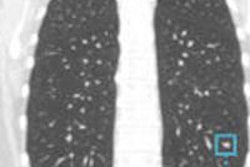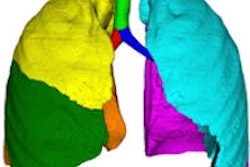
Three-dimensional volumetric measurements of lung cancer tumors are better predictors of survival than conventional Response Evaluation Criteria in Solid Tumors (RECIST) measurements, according to a new study published by the European Journal of Radiology.
Researchers from the U.S. and Republic of Ireland retrospectively examined patients receiving chemotherapy for lung cancer after their first and second treatment rounds, using two different volumetric measurement techniques to gauge treatment response. They compared both volumetric techniques with unidimensional RECIST measurements.
Volumetric measurements significantly outperformed RECIST for predicting overall survival, especially after the first round of treatment.
 Dr. Sarah Hayes from Memorial Sloan Kettering Cancer Center.
Dr. Sarah Hayes from Memorial Sloan Kettering Cancer Center.Volumetric measurements "selected the responders earlier than RECIST did, and that corresponded with increased overall survival for the patients," Dr. Sarah Hayes, assistant attending radiologist at Memorial Sloan Kettering Cancer Center in New York, told AuntMinnieEurope.com in an interview. Conversely, "when you looked at the RECIST criteria on responders versus nonresponders, there was actually no difference."
Between the two volumetric techniques, it was ellipsoid-based volumetric measurements -- not the spherical technique -- that identified treatment responders and partial responders earlier than RECIST, the group concluded. With more accurate delineation of responders from nonresponders, the results could improve clinical care for cancer patients, Hayes and colleagues wrote (EJR, March 2016, Vol. 85:3, pp. 524-533).
Introduced in 2000 and updated in 2009, RECIST criteria established unidimensional measurement of target lesions as the standard method of measuring treatment response. But while RECIST is quite practical and efficient for film-based radiography, it is problematic in the realm of digital imaging, where 3D measurement options are available.
And both RECIST versions have limitations. First, they can't be used for lesions 1 cm and smaller. Second, for irregularly shaped lesions, interobserver variability can reach as high as 45% for RECIST unidimensional measurements, and 53% for bidirectional measurements.
Newer CT scanners offer volumetric measurements of tumors and measurements, and studies have suggested that volumetry is more repeatable and reproducible than linear measurements, Hayes and colleagues wrote. Other modalities, including CT perfusion and diffusion-weighted MRI can also be used to measure treatment response.
But standardization of volumetric measurements and validation of the findings are needed before volumetric techniques are widely accepted and applied clinically. This study aimed to assess volumetric measurements on CT to examine the correlations between RECIST and volumetry in patients with lung adenocarcinoma receiving first-line chemotherapy.
The study included 44 patients with stage IV adenocarcinomas who were treated with a three-drug chemotherapy regimen. Patients underwent thin-section CT of the chest and other relevant disease sites at baseline on a 16-detector-row scanner (LightSpeed, GE Healthcare), after one and two 28-day cycles of chemotherapy, and every eight weeks thereafter.
The investigators used a novel semiautomated segmentation algorithm developed previously by Zhao et al to segment pulmonary nodules. The sum of the target lesion volumes was then compared with RECIST 1.1 results, which were read separately.
Two volumetric techniques
Two separate volumetric measurement schemes were used. In the first method, volumetric spherical measurements were based on volumetric response cutoffs from mathematical extrapolation of RECIST 200 guidelines to spherical volumes.
The second volumetric method, proposed by Schiavon et al in 2012, extrapolated RECIST measurements to an ellipsoid shape based on RECIST cutoffs for partial response (30% decrease in volume), stable disease, or disease progression (20% increase in volume).
Bland-Altman scatter plots and between-subject Spearman correlation coefficients were used to evaluate the correlation between the unidimensional RECIST measurements and volumetric measurements.
Patients who achieved partial response were deemed partial responders and those with stable disease or progressive disease were considered nonresponders.
At a mean follow-up of 50 months, 13 of the 42 patients survived and 29 had died, the group reported. A total of 147 lesions were analyzed, a mean of three per patient.
"Partial responders based on volumetric ellipsoid criteria had significantly better [overall survival] compared with partial responder patients based on the volumetric spherical criteria," (p = 0.008) Hayes et al reported. Patients who were nonresponders based on volumetric ellipsoid criteria had a significantly increased risk of dying relative to nonresponders.
There was a strong correlation between the unidimensional RECIST measurements and volumetric measurements (p = 0.853) at baseline (p = 0.861), at the first follow-up, (p = 0.843), at the second follow-up (p = 0.887), and overall between subjects, the group reported.
But there was no survival difference between responders and nonresponders assessed by RECIST criteria on first follow-up CT (p = 0.841), with one-year overall of 64% for both groups.
"All the positive results we found were using an ellipsoid method," Hayes said. "With the spherical volumetric method we didn't see any advantage over using RECIST, and I think that makes sense because in real life most primary lung tumors are not perfect circles, and an ellipsoid shape in most cases is probably going to be closest to the shape of these tumors. It was interesting that there was so much of a difference between the two volumetric methods but I think it does make sense."
Volumetric response on first follow-up CT appears to predict overall survivor better than RECIST, the team concluded. Predicting survival helps patients, she noted.
"If you can pick up the patients who are not responding to therapy you can take them off the trial earlier as opposed to waiting two, three, four cycles to identify the patients who are not responding," she said. "You're sparing those patients a lot of unnecessary side effects." Not identifying nonrepsonders "deprives them of the opportunity to move to another treatment or another clinical trial where they may respond and have a better clinical outcome."
In an era of personalized medicine, there are a lot of newer targeted therapies, making it more important than ever to optimize care for each patient, according to Hayes.
"Cancer is going to become more of a chronic disease, even stage IV lung cancer, which traditionally would have been seen as a life-ending event," she said. "I think we're going to see more of these patients in these trials living longer and I think it's important to try to optimize their care and use whatever technology they can."
The authors urged researchers to be cautious when using volumetric techniques to evaluate tumor response to novel therapies because of variations in how newer treatments may affect tumor size. Techniques also need to be standardized so they can be integrated into daily reporting, Hayes said.
"It would make sense in the future if volumetric measurement became the standard of care, both in clinical practice and in clinical trials, but I think there's a lot of work to get done to get to that point," she stated.
Volumetric techniques also need to be standardized among vendors, and the technology must become more affordable so that all practices can use it, not just large academic centers. "Ideally, I think it would be great to see future versions of RECIST adopting volumetric measurements, but I think a lot more research -- bigger studies than ours -- are going to be needed," she said.



















